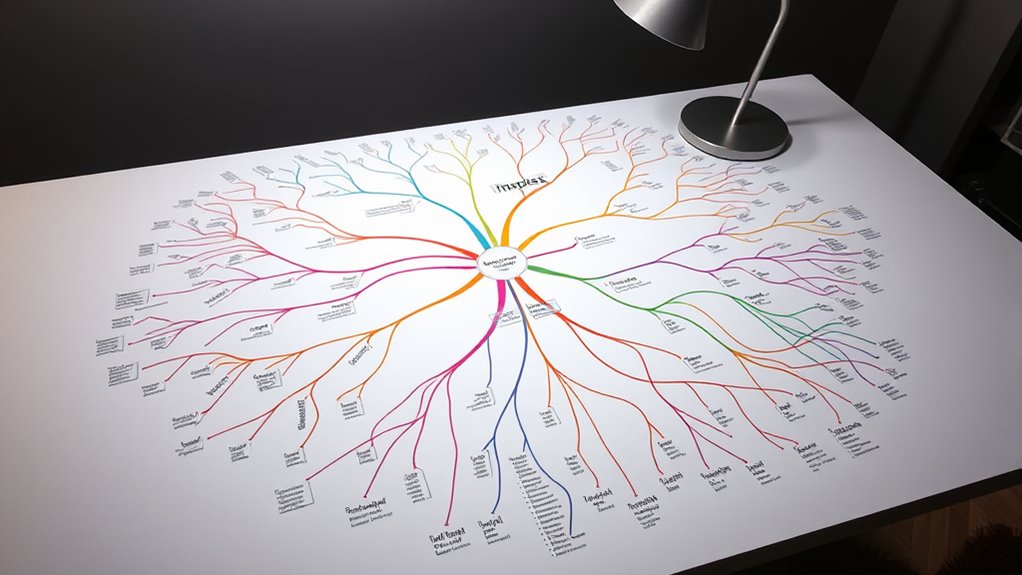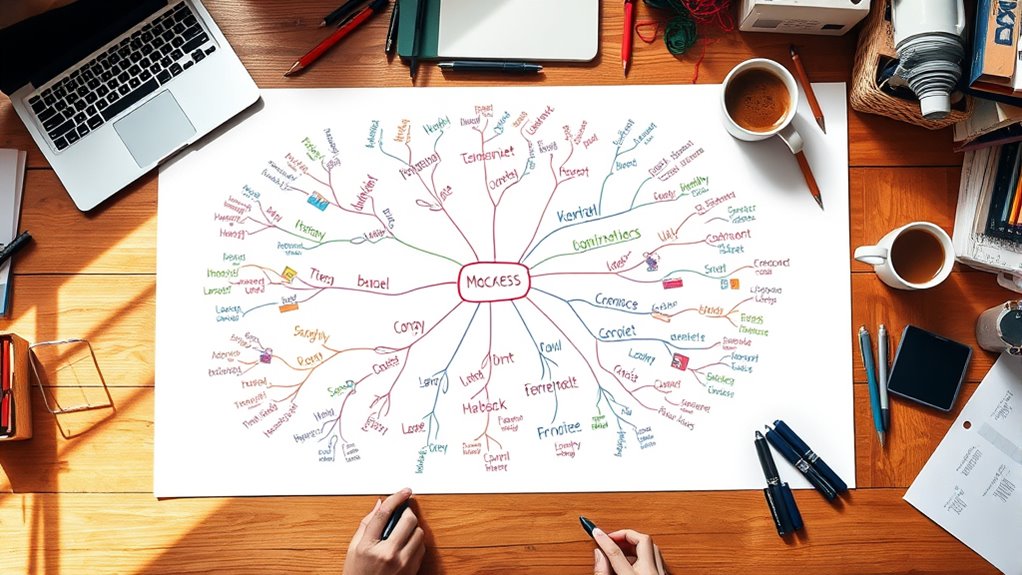Mind-mapping boosts your strategic thinking by helping you organize complex ideas visually and uncover hidden relationships, making it easier to see patterns and connections. It sparks creativity, encouraging you to explore new perspectives and challenge assumptions. This tool also sharpens your focus, clarifies goals, and simplifies planning. By visualizing potential risks and solutions, you can make smarter decisions and adapt more effectively. Keep exploring to discover how this powerful method can transform your strategic approach.
Key Takeaways
- Visualizes complex ideas and relationships to reveal patterns and enhance strategic insights.
- Organizes information clearly, helping identify priorities and develop actionable plans.
- Facilitates scenario planning and risk assessment for adaptive strategy development.
- Stimulates creative thinking by connecting unconventional ideas and exploring new perspectives.
- Improves team communication and collaboration, aligning diverse insights toward strategic goals.
Visualizing Complex Ideas and Relationships

Have you ever struggled to grasp a complicated concept or see how different ideas connect? That’s where visualizing complex ideas and relationships becomes vital. Using tools like conceptual frameworks helps organize your thoughts, making abstract ideas more tangible. Cognitive mapping allows you to create visual representations of these frameworks, revealing how various elements interact. By mapping out relationships, you gain clarity and insight, making it easier to analyze problems and identify patterns. This process transforms chaos into structure, enabling you to see the big picture and understand connections you might have overlooked. When you visualize your ideas, you’re better equipped to develop strategic solutions and communicate them effectively. Mind-mapping becomes an essential tool to clarify complexity and foster deeper understanding. Additionally, understanding industry trends can help you stay current and refine your strategic thinking skills.
Stimulating Creativity and Innovation

Building on your ability to visualize complex ideas, you can open new levels of creativity and innovation by actively engaging your mind in fresh ways. Mind-mapping boosts idea generation by encouraging unconventional connections and exploring diverse perspectives. To stimulate your creativity further, try these techniques:
- Use brainstorming techniques to break free from linear thinking
- Expand your mind map with random words or images to spark new ideas
- Combine unrelated concepts to create innovative solutions
- Challenge assumptions and ask “what if” to push boundaries
- Incorporate curiosity into your exploration to uncover novel insights and inspire deeper thinking
These methods help you unblock innovative thinking and foster creative breakthroughs. By leveraging mind-mapping as a tool for idea generation, you enhance your capacity for inventive solutions and fresh insights, driving strategic growth.
Improving Focus and Clarity in Planning

How can you sharpen your focus and bring clarity to your planning? Mindful focus helps you stay present and attentive, preventing distractions from clouding your judgment. Use mind-mapping to organize ideas visually, which clarifies complex concepts and highlights priorities. By establishing clear goals within your map, you create a roadmap that guides your actions and decisions. This process encourages you to break down large objectives into manageable steps, making your plan more attainable. When your focus is intentional, and your goals are explicit, you avoid confusion and stay aligned with your strategic vision. Mind-mapping acts as a mental filter, sharpening your concentration and ensuring your planning remains targeted and effective. Additionally, incorporating techniques like eye patch benefits can promote better relaxation and reduce fatigue, further enhancing your ability to focus and plan effectively. Ultimately, it transforms vague ideas into a clear, actionable plan.
Facilitating Problem Solving and Decision Making

When faced with complex problems or tough decisions, effective problem solving and decision making require clarity and focus. Mind-mapping helps you organize ideas visually, making it easier to identify key issues and explore solutions. During brainstorming sessions, you can quickly generate and connect ideas, revealing new perspectives. It also aids in risk assessment by visualizing potential consequences and challenges. This process encourages you to weigh options systematically, reducing uncertainty. With a clear map, you can prioritize actions, spot gaps, and streamline decision pathways. Mind-mapping keeps your thoughts structured, ensuring you don’t overlook critical factors. Additionally, understanding celebrity transformations can inspire innovative approaches to personal and professional challenges. Ultimately, it enhances your ability to approach problems confidently, make informed choices, and implement effective solutions quickly.
Enhancing Collaboration and Communication

Effective problem solving and decision making often hinge on clear communication and strong collaboration. Mind-mapping helps you visualize ideas, making it easier to share perspectives with your team. This process fosters team building by encouraging everyone to contribute and see how their input connects. As ideas become clearer, conflicts are more straightforward to resolve because everyone understands the underlying issues. Using mind-maps, you can identify areas of disagreement early and address them constructively. This promotes open dialogue and strengthens trust within the team. Better communication through visual tools reduces misunderstandings and streamlines collaboration. By actively involving everyone, you create an environment where conflict resolution becomes more efficient, ultimately leading to more cohesive, effective teamwork and better strategic outcomes. Incorporating diverse designs and materials from unique planters can also inspire innovative thinking and creative problem-solving within teams.
Adapting Strategies to Changing Environments

Adapting strategies to changing environments requires you to stay alert and flexible as conditions evolve. Using tools like scenario planning helps you visualize various future states, enabling better preparation. Conducting regular risk assessments allows you to identify potential threats early and adjust your approach accordingly. Staying open to new information ensures your strategies remain relevant amid rapid shifts. Mind-mapping aids this process by visually organizing possible scenarios and responses. Consider these steps:
- Continuously update your scenario plans based on new data
- Prioritize risks to focus your adaptation efforts
- Incorporate feedback from team members to refine strategies
- Keep contingency plans ready for unforeseen changes
- Leveraging powerful persuasive words can enhance your strategic communication and influence decision-making effectively.
Frequently Asked Questions
Can Mind-Mapping Be Integrated With Other Strategic Planning Tools?
You can definitely integrate mind-mapping with other strategic planning tools through digital integration, making the process seamless and efficient. This allows you to combine visual brainstorming with data analysis or SWOT analysis, enhancing clarity and decision-making. Using collaborative approaches, you involve team members in real-time, fostering diverse perspectives and innovations. Such integration streamlines your strategy sessions, improves communication, and helps you develop thorough plans more effectively.
What Are the Limitations of Using Mind-Mapping for Strategic Thinking?
Did you know 60% of strategic decisions fail due to cognitive overload? When using mind-mapping, you might face limitations like oversimplification risks, which can hide complex issues. It’s easy to overlook details or get overwhelmed if your map becomes too cluttered. While helpful, mind-mapping shouldn’t replace thorough analysis, as it can lead you to focus on surface-level connections rather than deeper insights.
How Does Mind-Mapping Influence Long-Term Strategic Decision-Making?
You leverage visualization techniques like mind-mapping to improve long-term strategic decision-making by creating clear cognitive maps of complex ideas. This process helps you identify patterns, connections, and potential future scenarios, making your planning more all-encompassing. By actively engaging with these visual tools, you enhance your ability to foresee risks and opportunities, enabling smarter, more informed decisions that align with your long-term goals.
Are There Specific Industries That Benefit Most From Mind-Mapping Techniques?
Imagine a creative industry or tech company lost in a fog of chaos, desperately searching for clarity. You’ll find mind-mapping your guiding lighthouse there. These techniques work wonders in creative industries, sparking innovation, and in technology sectors, organizing complex projects. You’ll see how visual maps streamline ideas, inspire breakthroughs, and foster strategic thinking, making these fields the prime beneficiaries of this clever, almost magical, cognitive tool.
What Training or Skills Are Needed to Maximize Mind-Mapping Effectiveness?
To maximize mind-mapping effectiveness, you need strong visualization skills and creativity development. Focus on practicing how to create clear, vivid images in your mind and organize ideas visually. Developing these skills helps you see connections more easily and generate innovative solutions. You should also learn to be flexible, open-minded, and practice regularly to refine your ability to use mind-mapping as a powerful strategic thinking tool.
Conclusion
By harnessing mind-mapping, you turn your thoughts into a vibrant tapestry, making complex ideas easier to navigate. It’s like having a mental GPS that guides you through innovation, focus, and collaboration. As your strategies adapt to changing landscapes, this tool becomes your compass, ensuring you stay on course. Embrace mind-mapping, and watch your strategic thinking bloom like a well-tended garden—full of endless possibilities waiting to be uncovered.









